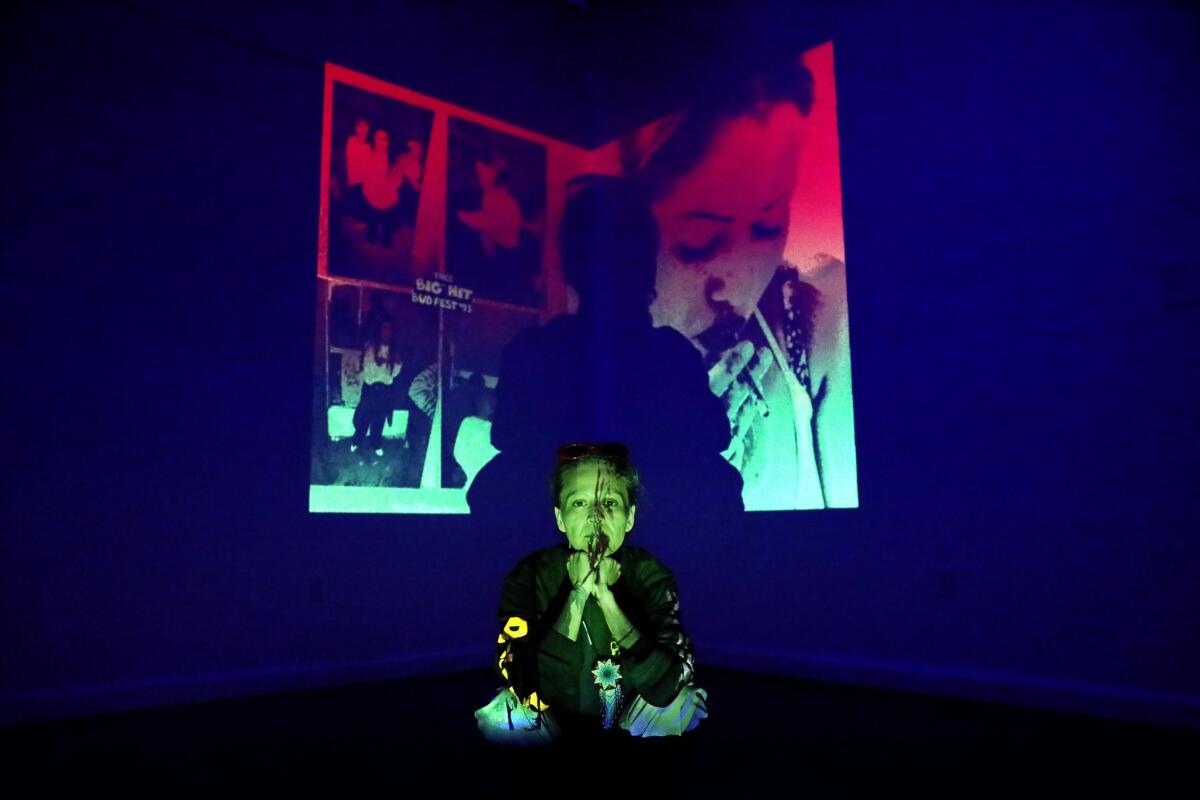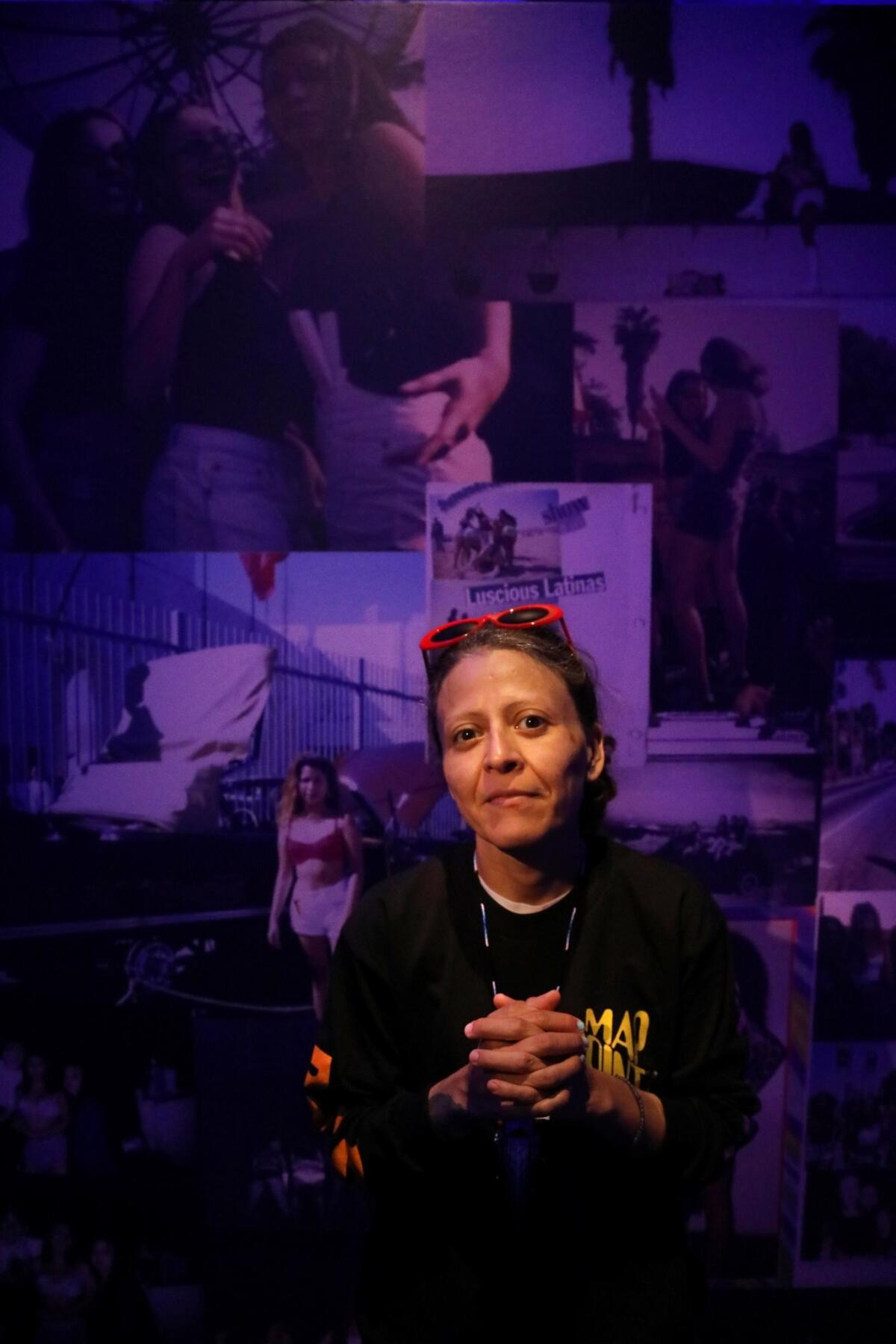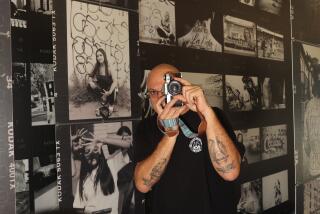Guadalupe Rosales used Instagram to create an archive of Chicano youth of the ‘90s — now it’s an art installation

In a small stack of photographs, a couple of magazines and an Instagram account, Guadalupe Rosales found the spark of inspiration that led to her first solo museum exhibition, “Echoes of a Collective Memory,” an installation that occupies an entire gallery at the Vincent Price Art Museum.
The photos were wallet-size — gauzy portraits of friends taken in mall photo studios known as “star shots.” The magazines were a pair of worn copies of Street Beat, the 1990s bi-monthly that chronicled the intersection of Chicano youth and the underground party scene, a publication The Times once described as “Rolling Stone for La Raza.”
These were objects of adolescence for Rosales, who grew up on Los Angeles’ Eastside. Over time, they became charged with the residue of nostalgia. Young men in baggy pants and rave beads; girls with hairdos crunchy from mousse, crimson lips trimmed with Jordana lip liner — all redolent of a Los Angeles of an earlier time. It was the ’90s, a decade of peak gang violence, the anti-immigrant politics of Prop. 187, and underground parties teaming with house beats and techno’s hard-driving synth.
To Rosales, 38, these personal tokens signified the markers of Mexican American life as she lived it, not as has generally been depicted in mainstream media. “The way we’ve been represented,” she says as she stands in the Vincent Price gallery, “doesn’t represent me.”
They have also formed the basis of an expansive archive amassed by the artist that is largely devoted to the popular culture of ’90s Chicano youth, but which on “Veteranas and Rucas,” the Instagram account she’s become known for, goes back to the ’70s and ’60s, even the 1940s and its Zoot Suit Riots.
“Veteranas and Rucas” began as a lark. It was 2015 and Rosales posted a few ’90s images to Instagram and invited others to send in their own “throwback photos.” Of that initial post, she says, “I was just trying to connect with my family and culture.”
The connections poured in. Readers from all over — Venice, El Monte, Santa Ana, Ontario and Boyle Heights — submitted hundreds of digital images. Others submitted physical photographs, articles of clothing and old party flyers. Soon after, as the submissions began to span multiple decades, she started a second Instagram account, Map Pointz, devoted specifically to ’90s party culture.
“I’ve gotten so many emails, people thanking me, saying, ‘I’m so glad that there is something out there that is representing a part of our culture,’” Rosales says of her Instagram accounts. “It’s nice to hear that. It validates that there was something missing — part of history.”
Between the social media contributions and her own research, Rosales has built up a substantial archive. This includes countless images that serve as documents of the extravagant hair and makeup of different eras — as well as party flyers and other keepsakes that advertised party crews, the groups of friends that staged underground dance jams in SoCal storefronts, warehouses and backyards.
The archive, along with the installations that Rosales has created to display it, have garnered her a significant art world following. Last month, her work materialized on the cover of Aperture magazine’s fall issue, devoted to artists from Los Angeles. Next month, Little Big Man press will publish her first book: “Map Pointz: A Collective Memory,” based on her exploration of ’90s Chicano party crews.
She is also the subject of solo shows on two coasts — not only the Vincent Price Art Museum exhibit “Echoes of a Collective Memory” at East Los Angeles College, but “Legends Never Die, A Collective Memory,” an archival exhibition on view at the Aperture Foundation’s gallery in New York City.
On a warm Tuesday afternoon, Rosales pokes around her installation at the Vincent Price to make sure all is in place. She is slender with sharp features and a style that leans toward the androgynous: baggy pants and a loose tee accompanied by a pair of glam, cherry-red sunglasses.
Exhibitions that present archival material can often feel scientific, full of objects in vitrines. But at VPAM, Rosales has used elements of her archive — photos, posters, a set of rave beads — in ambitious and imaginative ways, placing them in a neon-lit environment that evokes the feeling of an underground club.
Muffled beats emanate from a structure papered in party flyers that bear titles such as “Southgate Madness” and “Grab Your Nalgas!” Pick up a pay phone in the hallway and you hear a recording of a young woman named Dazzle of the East L.A. Q-Teez giving the latest party updates. “If I got the time,” she says coyly, “I’ll get back to you … late.”
“It’s the feeling of walking into that party,” says Rosales of her installation. “Even before walking into the party, that sound. I will forever remember that. It’s like, I can hear the music; it’s getting louder because we are getting closer. That was such a good feeling — being with friends and listening to good music.”
The way we’ve been represented doesn’t represent me.
— Guadalupe Rosales, artist
A pair of illuminated go-go boxes bear more images. Portraits of girls posing and boys dancing flash on the wall. Utter the words “culture of the 1990s” and chances are you’ll conjure images of “Melrose Place” and Generation X. Rosales’ installation is a reminder of all that goes overlooked.
VPAM director Pilar Tompkins Rivas notes that the mainstream media represent Chicanos in “a very limited way.”
“Think of Hollywood,” she adds. “You just don’t see Chicanos. [Guadalupe is] making us see what they do as a valid form of cultural expression.”
It all comes at a moment in which other artists and curators are also revising cultural histories that have been absent the Chicano presence. The past year in L.A. has seen exhibitions devoted to queer Chicano artists, Chicano photography and Teen Angels magazine (another vintage source of Chicano pop culture).
Rosales’ focus on women is especially poignant given the ways in which Latinas have been underrepresented and misrepresented, often in highly sexualized ways.
“She’s building this archive of images of women that mass media doesn’t have,” says Tompkins Rivas. “It’s an important exercise in feminism.”
Study the images and you’ll find black hair, black eyes and indigenous features, styles that range from the coyly feminine to the androgynous, gazes of resolute strength.
“There is this amazing self-presentation that is happening in terms of style and identity,” says Aperture editor Michael Famighetti. “It’s people representing themselves on their own terms as they want to be seen.”
“Echoes of a Collective Memory” contends with more difficult issues too — namely in the form of an altar to the artist’s cousin Ever Sánchez, who was stabbed to death at a party in 1996.
His story is emblematic of the unexpected twists a life can take: a dedicated high school football player who never missed class but fell into a gang in the wake of a bad breakup.
“A month later he was killed,” says Rosales. “It was so fast.”
Sánchez lived with her family — “he was like a brother” — and in the wake of his death, Rosales and her sister had to clear out his things. She says she will never forget the smell of his clothes, which bore traces of Cool Water cologne.
A bottle of Cool Water now rests on a go-go box in the VPAM show. She picks it up and sprays it into the air, and the gallery takes on the scent of a high school dance.
In her archive, the artist hasn’t shied away from showing depictions of gang life: groups of pompadoured women throwing gang symbols and bloody initiation rites.
“It is part of the story,” she says. “It just is. Just like we talk about the fun times and friendships, we can also talk about the traumas and the violence.”
::
Rosales was born to Mexican immigrants in Northern California and came to live in Los Angeles at age 4, first in Boyle Heights, then East L.A. Though she had always been interested in becoming an artist, some of her early efforts — namely, a photography class at Schurr High School — didn’t initially pan out.
“I didn’t know how to mix my chemicals,” she says with a laugh. “My pictures would turn brown right away … I think I failed.”
At 14, she found purpose in the underground party scene. Soon enough, she and her friends had established their own party crew, Aztek Nation (represented in the show by a baseball cap).
“It was living in the moment,” she says of the dance floor. “Freedom, for sure.”
But the death of her cousin rolled in like a fog of darkness. “I was extremely depressed,” she recalls. “You don’t want to eat. You can’t sleep.”
Though she attended all four years of high school, she failed to get a diploma due to regular absences. “My mind,” she says, “just wasn’t in it.”
In 2000, she took up a friend’s offer to go to New York. The trip was supposed to last a week. It went on for 15 years.
New York reconnected her with her desire to become an artist. It happened one night as she and a friend spied an art opening spilling out onto a Brooklyn street.
“I don’t think I’d been to an opening at that point,” she remembers. “I entered this space and it was all queer. This guy gives a speech, and he is standing on a chair, and he says, ‘I don’t know why all these feminists invited me here, but they’re my friends, and maybe they invited me because I’m a fag!’”
She laughs. “I was like, ‘Omigod, this is amazing!”
At the time, Rosales had recently come out, but remained low-key about her sexuality. In that Brooklyn gallery, she says, “I found a part of myself.”
She also found her artistic milieu: LTTR, a loosely organized feminist, genderqueer artist collective, with which she would collaborate. She began making drawings inspired by geometric patterns and once again picked up a camera. Around 2011, she had her first artist’s residency — in her mother’s home state of Michoacán. There she created a series of paintings on Mylar that she employed as photographic filters to create works that create the sensation of a double exposure.

Her work caught the eye of Gregg Bordowitz, who suggested she apply for the Low-Residency MFA program at the School of the Art Institute of Chicago, where he teaches.
“I told him, ‘I don’t have any school background,’” she recalls. “He said, ‘I’ve seen your work. You should apply.’”
She got in — without the benefit of a high school diploma or college degree. In 2016, she received her master’s in fine arts.
It was in art school that she set up her Veteranas and Rucas and Map Pointz accounts.
“It was a way for me to connect with L.A. without being in L.A.,” she says. “I missed home, but I wasn’t ready to say that.”
Since 2016, she has once again called Los Angeles home. And she has worked on weaving together the fragments of memory that each person sends her into a more powerful whole.
The VPAM installation contains humor — party flyers that riff on sex and drugs and inside jokes. But with its moody blue neon, it is reverent too.
“It feels like a temple,” says Rosales, looking satisfied.
A temple to her youth. And to Ever Sánchez too.
“Guadalupe Rosales: Echoes of a Collective Memory”
Where: Vincent Price Art Museum at East Los Angeles College, 1301 Cesar Chavez Ave., Monterey Park
When: Through Jan. 19
Info: vincentpriceartmuseum.org
ALSO
Look what happens when you interview artist and Instagram sensation Guadalupe Rosales via text image
EJ Hill stood on a podium at the Hammer for 78 days in a work about race, art and winning
Sign up for our weekly Essential Arts & Culture newsletter »
[email protected] | Twitter: @cmonstah
More to Read
The biggest entertainment stories
Get our big stories about Hollywood, film, television, music, arts, culture and more right in your inbox as soon as they publish.
You may occasionally receive promotional content from the Los Angeles Times.











